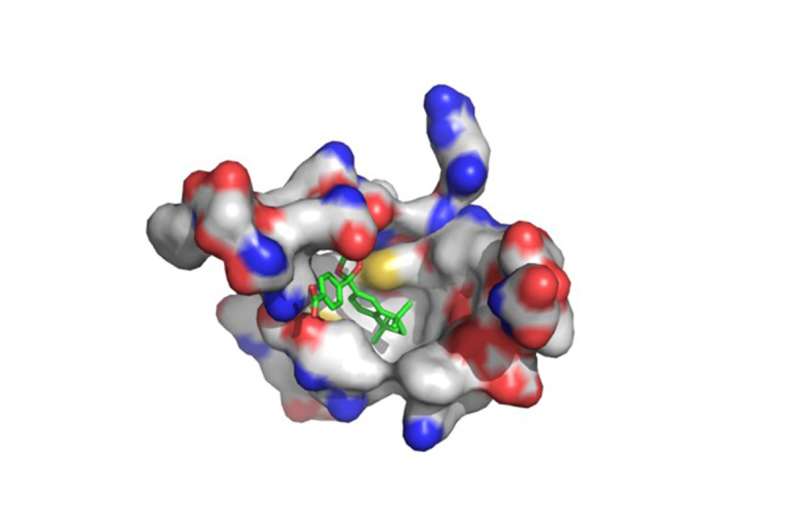New drug seeks receptors in sarcoma cells, attacks tumors in animal trials

A new compound that targets a receptor within sarcoma cancer cells shrank tumors and hampered their ability to spread in mice and pigs, a study from researchers at the University of Illinois reports.
The researchers conducted a multi-year, cross-disciplinary study that went from screening potential drug candidates to identifying and synthesizing one compound, to packaging it into nanoparticles for delivery in cells, to testing it in cell cultures and finally in mice and pigs with sarcoma tumors.
"There's a very poor prognosis with sarcomas. Sarcomas are rare tumors, but they are so heterogeneous that they're very difficult to treat," said study leader Dipanjan Pan, a professor of bioengineering and in the Carle Illinois College of Medicine. "The receptor we targeted inside the cancer cells, the orphan nuclear receptor, is a more universal target for the varied sarcomas than markers on the surface of cells. The opportunity is huge, because this receptor is also expressed in other types of solid cancers—melanoma or liver cancers, for example."
Pan's group collaborated with Lawrence Schook, a professor of animal sciences and an expert in pig physiology and biomedical research. Pigs share many similarities of anatomy and physiology with humans, said Schook, who is affiliated with the Carl R. Woese Institute for Genomic Biology and the Beckman Institute for Advanced Science and Technology at Illinois. His group developed a special type of cancer-susceptible pigs called "oncopigs."
"Oncopigs are engineered to have the major mutations that cause human cancers. Thus, tumors can be generated in any tissues at any time," said Schook.
The researchers targeted a protein called retinoid X receptor, which is abundant in sarcoma and other cancer cells but has low concentrations in healthy cells. A drug class targeting RXR has been developed, but it is very toxic and is limited to topical application at the clinic. While working to reduce the toxicity, Pan's group found that the elongated structure of the clinically approved drug does not exactly match the globular shape of the target protein. The researchers decided to look for new compounds that would fit RXR better, offering more activity and fewer side effects.
They began by computationally screening more than 20,000 compounds, looking for structures that would best match the RXR target. They narrowed the field to a handful of candidates, then picked the most promising one to synthesize in the lab.
After producing the compound, the researchers found that it doesn't dissolve in water—which means it won't be easy for the body to use, Pan said. To solve this issue, the group designed a nanoparticle within which the drug candidate could be packaged for transport and delivery inside the cancer cells.
The researchers tested the compound for efficacy and toxicity, first in tissue cultures in the lab, then in mice with tumors that formed from injected cancer cells, then in oncopigs that had developed sarcomas of the skin.
They found that their new drug candidate was more than three times more effective than currently available drugs, Pan said. Not only did the tumors shrink, but the cancer cells were less likely to multiply and were less mobile, reducing their ability to spread to other tissues. The researchers did not see any significant toxic activity, but they did observe minor side effects that seemed to subside over time. They cautioned that further study is needed to determine side effects and effective dosages.
Lastly, the researchers removed the tumors to study what the drug was doing inside the cell and how the body metabolized it.
"We saw that the tumor was shrinking, but that doesn't mean the drug is working the way it's supposed to work," Pan said. "We wanted to make sure that the drug was actively participating in the pathway we intended, and that it wasn't just killing cells because it's toxic.
"Interestingly, the mouse and the pig tumor data correlated with each other, and both of them corroborated our hypothesis. The drug is acting the same way in completely different species," said Pan, who also is affiliated with the Beckman Institute.
The researchers plan to conduct a clinical trial in dogs with osteosarcoma. Dogs develop such tumors spontaneously, as humans do, and treatment is difficult. The researchers also plan to conduct escalation studies—increasing dosages to see what concentration is the most safe and effective—and to further investigate any side effects or toxicities.
"We'd like to look at other cancers as well. This is not just for sarcoma. Wherever RXR is upregulated—for example, in melanoma or liver cancer—these agents could be utilized," Pan said. "RXR and other retinoid receptors also are active in Alzheimer's disease, so that's another thing we could explore."
More information: Mao Ye et al, Design, Synthesis, and Characterization of Globular Orphan Nuclear Receptor Regulator with Biological Activity in Soft Tissue Sarcoma, Journal of Medicinal Chemistry (2018). DOI: 10.1021/acs.jmedchem.8b01387




















